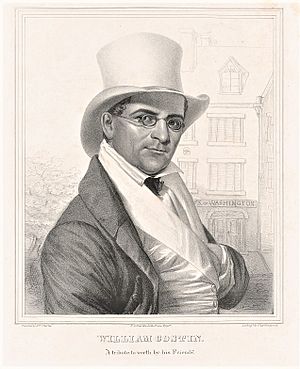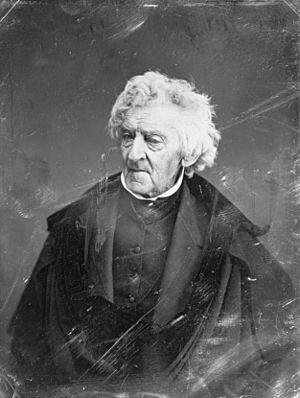William Costin facts for kids
Quick facts for kids
William "Billy" Custis-Costin
|
|
|---|---|

Costin in 1842
|
|
| Born | c. 1780 |
| Died | May 31, 1842 (aged 61–62) |
| Known for | Early civil rights |
| Spouse(s) | Philadelphia "Delphy" Judge |
William "Billy" Costin (born around 1780 – died May 31, 1842) was an important African-American activist. He was a free man who fought against unfair laws in Washington, D.C.. He won a big case in court that helped other free Black people.
Contents
William Costin's Early Life
Not much is known about William Costin's early life. His mother, Ann Dandridge-Costin, was enslaved. Some say her father was Colonel John Dandridge, which would make her the half-sister of Martha Washington.
Ann Dandridge-Costin was believed to be of African and Cherokee heritage. Even though Native American slavery had ended, she was still considered enslaved because of laws that focused on African ancestry. Ann and some of her children lived at the Mount Vernon plantation, owned by George Washington. It was located on the Potomac River in Fairfax County, Virginia. However, there is no proof that William Costin lived there. He might have lived nearby with other family members.
Historians still discuss whether Costin was born free or enslaved. They also debate who his father was.
Costin's Career and Community Work
Around 1800, Costin moved from Mount Vernon to Washington, D.C.. At that time, he married Philadelphia "Delphy" Judge. Martha Washington had given Delphy to her granddaughter, Elizabeth Parke Custis Law, as a wedding gift in 1796. Delphy and her children were later freed in 1807 by Elizabeth's husband, Thomas Law.
In 1812, Costin built a house on Capitol Hill. There, he and Delphy raised their large family. From 1818, Costin worked as a porter at the Bank of Washington. He saved his money and bought properties in the growing capital city.
Helping Start a School
In 1818, Costin helped start a school for African-American children. His daughter, Louisa Parke Costin, later became its leader. This was known as the first public school for Black children in Washington, D.C. During the Snow Riot in August 1835, a white mob burned many buildings linked to free Black people. However, they spared Costin's school.
Creating Community Organizations
Costin also helped create other important organizations:
- In 1821, he helped found the Israel Colored Methodist Episcopal Church. This church was led by an African-American minister.
- In June 1825, Costin helped start an African-American masonic lodge. It was called Social Lodge #1.
- In December 1825, he helped create the Columbian Harmony Society. This group provided burial benefits and a cemetery for African Americans. Costin served as the Society's vice president through 1826. He worked with friends like William Wormley and George Bell on these projects.
Challenging Unfair Laws
Fighting the Surety Bond Law
In 1821, William Costin bravely challenged a part of the "Black Code" in Washington, D.C. This law tried to stop free African Americans from living in the city. The mayor, Samuel Nicholas Smallwood, supported this law.
The law said that free Black people had to:
- Go before the mayor with papers signed by three "respectable" white neighbors. These papers had to say they were good people and could support themselves.
- If the mayor agreed, they had to pay a yearly $20 bond. A "good and respectable" white person had to promise they would behave well. This bond also made sure they would not become beggars.
Costin refused to follow this unfair law. He was fined five dollars by a judge. Costin then decided to appeal his fine to a higher court.
The Court's Decision
In court, Chief Justice William Cranch agreed that the city had the power to set rules for free Black people living there. Cranch was a nephew of the second U.S. President, John Adams. Costin asked the court to get rid of the law completely. He argued that Congress could not give the city powers that went against the Constitution. He also stated that the Constitution "knows no distinction of color."
Cranch defended the law by pointing to other state laws that limited the rights of Black people, such as voting or serving on juries. He wrote that the Constitution does not stop states from denying some rights to certain citizens.
However, Cranch also admitted that the law was unfair to free Black people who had lived in the city for a long time. He noted that they could not force white people to give them surety. He also worried that the law could break families apart.
In the end, Cranch ruled that those who had lived in the District before the law was passed were exempt. This meant they did not have to follow it. He said, "It would seem to be unreasonable to suppose that Congress intended to give the [city] corporation the power to banish those free persons of color who had been guilty of no crime." This was a big win for Costin and other free Black residents.
William Costin's Family Life
Marriage and Family
In 1800, Costin married Philadelphia "Delphy" Judge (born around 1779 – died December 13, 1831). Delphy was the younger sister of Oney "Ona" Maria, also known as Oney Judge. Both sisters were daughters of Betty Davis and were "dower" slaves of Martha Washington at Mount Vernon. This meant they were part of Martha Washington's property from her first marriage.
According to Virginia law, these dower slaves would go to Martha's grandchildren after her death.
Buying Freedom for Relatives
Costin worked hard to buy the freedom of his relatives. In 1807 and 1820, he bought the freedom of seven family members.
- In 1807, Thomas Law freed six of Costin's sisters and half-sisters for a very small amount of money. Thomas Law was married to Elizabeth Parke Custis Law, who had inherited these enslaved people from her grandmother, Martha Washington.
- In October 1820, Costin bought his cousin, Leanthe, who worked at the Mount Vernon Mansion House. George Washington Parke Custis sold her to Costin. Twelve days later, Costin freed her for "five dollars."
Costin remained on good terms with the Custis family throughout his life. In 1835, Eliza's brother, George Washington Parke Custis, even supported Costin's side business of driving a horse-and-buggy taxi.
William Costin's Funeral
William Costin's funeral was held on June 4, 1842. Many people attended, including U.S. Attorney Francis Scott Key. Key was famous for writing the song that later became the national anthem.
The funeral was special because of the long line of horse-drawn taxis driven by Costin's friends. Both white and Black mourners were part of the funeral procession, which also included people on horseback.



